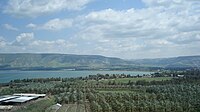Tourism in Israel is a major economic sector and a significant source of national income. Israel offers a plethora of historical and religious sites, beach resorts, natural sites, archaeological tourism, heritage tourism, adventure tourism, and ecotourism. For practical reasons, this article also covers tourism in the West Bank and the Golan Heights, since it is closely interconnected with the mass tourism in Israel. In 2019, Israel saw a record 4.55 million tourist arrivals,[1] with tourism contributing NIS 20 billion to the national economy in 2017.[2][3][4][5]
Jerusalem is a central destination for tourists, home to sites such as the Western Wall, the Church of the Holy Sepulchre, and the Dome of the Rock. The city also offers numerous cultural and historical attractions, including the Israel Museum and Yad Vashem. Tel Aviv is renowned for its lively nightlife, cultural festivals, and Mediterranean beaches, and the "White City" district, appealing to both local and international visitors. Other notable attractions include the Dead Sea, famous for its high salinity and therapeutic benefits, Haifa and its Baháʼí Gardens, and archaeological sites like Masada, Beit She'an and Caesarea. The Negev Desert offers natural tourism opportunities at locations such as Ramon Crater and Timna Valley, with activities including hiking, camel trekking, and stargazing, while Eilat's Coral Beach Nature Reserve, located in the Red Sea, attracts diving enthusiasts. The Galilee provides a variety of activities such as boating, cycling, and bird watching, alongside its religious sites. Israel has the highest number of museums per capita in the world with over 200 museums.[6][7]
Religious tourism is very popular in Israel and in the West Bank. Over the millennia, the Holy Land has been amongst the most visited lands in the world.[8] Many sites in modern Israel are considered holy in Christianity and Judaism due to their mention in the Hebrew Bible and the New Testament. As of 2007, the Western Wall and the Tomb of Rashbi were the most visited Jewish religious sites.[9] The most visited Christian holy sites include the Church of the Holy Sepulchre in Jerusalem, the Church of the Nativity in Bethlehem, and the Basilica of the Annunciation in Nazareth. The most visited Islamic religious sites are the Temple Mount (Al-Aqsa Mosque) in Jerusalem and the Cave of the Patriarchs in Hebron.
In 2017, the most popular paid tourist attraction is Masada.[10] The most visited city was Jerusalem and the most visited site was the Western Wall. The largest percentage of tourists came from the United States accounting for 19% of all tourists, followed by Russia, France, Germany, the United Kingdom, China, Italy, Poland, and Canada.[11]
- ^ "Israel welcomes record-breaking 4.55 million tourists in 2019". jpost. December 29, 2019.
- ^ Yan (January 3, 2018). "Israel sees record 3.6 mln inbound tourists in 2017". Xinhua News Agency. Archived from the original on January 24, 2018.
- ^ Amir, Rebecca Stadlen (January 3, 2018). "Israel sets new record with 3.6 million tourists in 2017". Israel21.
- ^ Raz-Chaimovich, Michal (December 27, 2017). "Record 3.6m tourists visit Israel in 2017". Globes.
- ^ "Israel Sees Record 3.6 Million Tourists in 2017". Atlanta Jewish Times. January 4, 2018. Archived from the original on January 11, 2018.
- ^ "CNN's Top 10 Israel Museums Lists 4 Jerusalem Museums - iTravelJerusalem". www.itraveljerusalem.com. Retrieved February 14, 2024.
- ^ Press, Viva Sarah (May 13, 2013). "13 must-see museums in Israel". ISRAEL21c. Retrieved February 14, 2024.
- ^ Nepi, Serena Di (December 1, 2013). "Travels to the "Holy Land": Perceptions, Representations and Narratives". Quest. Issues in Contemporary Jewish History. Retrieved February 20, 2024.
- ^ Irit Rosenblum & Eli Ashkenazi (January 7, 2007). "For first time, religious sites to get state budget of NIS 6.3M". Haaretz.
- ^ Timor, Ilai (April 8, 2009). "Masada tourists' favorite spot in Israel". Ynetnews. Retrieved April 8, 2009.
- ^ Raz-Chaimovich, Michal (December 27, 2017). "Record 3.6m tourists visit Israel in 2017". Globes.


